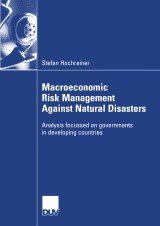Details

Macroeconomic Risk Management Against Natural Disasters
Analysis focussed on governments in developing countries|
53,49 € |
|
| Verlag: | Deutscher Universitätsverlag |
| Format: | |
| Veröffentl.: | 14.12.2007 |
| ISBN/EAN: | 9783835094413 |
| Sprache: | englisch |
| Anzahl Seiten: | 201 |
Dieses eBook enthält ein Wasserzeichen.
Beschreibungen
Looking back in history, we conceive the twentieth century as the century of wars. Most Hkely, we will conceive the twenty-first century as the century of (natural) catastrophes. Wars can be avoided (unfortunately, it did not happen often in history), in contrast, most natural disasters are outside human influence. However, the consequences of disasters can be alleviated by means of risk management. For an effective risk management, information is needed about (i) the size of the risk (measured by the frequency and intensity of the hazard), and (ii) the degree of vulnerability of the economy and society. Stefan Hochr- ner's thesis deals with measuring and modehng of both. While the physical risk modeUng is a well developed area within statistical modeling (frequency analysis, point processes, extreme value theory, etc. ), estimating the economic consequences is a more challenging task. The author studies economic effects of catastrophes by statistical analysis of mac- economic data. One interesting finding is that disasters can decrease the absolute level of economic performance, such as the GDP, while keeping growth levels nearly the same (at least after some years) as in the pre-disaster years. The boom of new products in the financial markets, especially of new derivative instru ments, has led to new risk hedging instruments such as catastrophe bonds. CAT-bonds transfer the risk to the market of investors.
Natural disaster risk.- Economic impacts - Statistical analysis.- Natural disaster risk management measures.- Financial resilience of the public sector.- Catastrophe modeling and simulation.- Case Studies.- Conclusion and future work.
Dr. Stefan Hochrainer promovierte bei o. Prof. Dr. Georg Pflug am Institut für Statistik und Decision Support Systems der Universität Wien. Er ist am International Institute for Applied System Analysis (IIASA), Laxenburg, tätig.
Natural disasters cause considerable economic damage. While developed countries usually are able to cope with the impacts of natural hazards, developing countries are faced with severe consequences for their resources. In order to prevent long-term macroeconomic repercussions, governments need a comprehensive disaster risk management strategy. <br>
<br>
Stefan Hochrainer develops a catastrophe risk management model. It illustrates which trade-offs and choices a country must make in managing economic risks due to natural disasters. Budgetary resources are allocated to pre-disaster risk management strategies to reduce the probability of financing gaps. The framework and model approach allows cross country comparisons as well as the assessment of financial vulnerability, macroeconomic risk, and risk management strategies. Three case studies demonstrate its flexibility and coherent approach.<br>
<br>
Stefan Hochrainer develops a catastrophe risk management model. It illustrates which trade-offs and choices a country must make in managing economic risks due to natural disasters. Budgetary resources are allocated to pre-disaster risk management strategies to reduce the probability of financing gaps. The framework and model approach allows cross country comparisons as well as the assessment of financial vulnerability, macroeconomic risk, and risk management strategies. Three case studies demonstrate its flexibility and coherent approach.<br>
Natural disasters cause considerable economic damage. While developed countries usually are able to cope with the impacts of natural hazards, developing countries are faced with severe consequences for their resources. In order to prevent long-term macroeconomic repercussions, governments need a comprehensive disaster risk management strategy. <br>
<br>
Stefan Hochrainer develops a catastrophe risk management model. It illustrates which trade-offs and choices a country must make in managing economic risks due to natural disasters. Budgetary resources are allocated to pre-disaster risk management strategies to reduce the probability of financing gaps. The framework and model approach allows cross country comparisons as well as the assessment of financial vulnerability, macroeconomic risk, and risk management strategies. Three case studies demonstrate its flexibility and coherent approach.<br>
<br>
Stefan Hochrainer develops a catastrophe risk management model. It illustrates which trade-offs and choices a country must make in managing economic risks due to natural disasters. Budgetary resources are allocated to pre-disaster risk management strategies to reduce the probability of financing gaps. The framework and model approach allows cross country comparisons as well as the assessment of financial vulnerability, macroeconomic risk, and risk management strategies. Three case studies demonstrate its flexibility and coherent approach.<br>
Diese Produkte könnten Sie auch interessieren:

Zur Begründung eines progressiven Einkommensteuertarifs aus der Perspektive der Gleichmäßigkeit der Besteuerung

von: Mark Heitfeldt

59,99 €

Municipal Finances and the Adoption of Participatory Budgeting in Germany

von: Janina Apostolou

96,29 €














